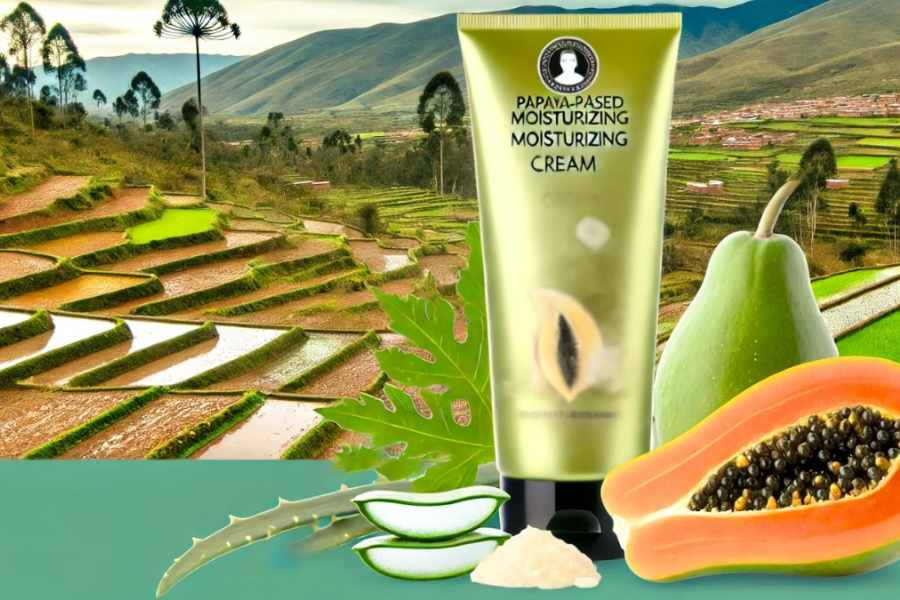Papaya, a tropical fruit abundant in vitamins and enzymes, has long been recognized for its skincare benefits. In Peru, where the use of natural ingredients in health and beauty products is a cultural cornerstone, the exploration of papaya as a key ingredient in moisturizers is particularly relevant. The development of a “crema hidratante de papaya en Perú” within a doctoral thesis represents a scholarly pursuit to investigate the effectiveness and potential of papaya in skincare formulations. This article delves into the nuances of such a thesis, its significance, and its contributions to the field of natural skincare.
The Growing Interest in Natural Skincare
As the global beauty industry shifts towards natural and organic products, consumers are increasingly aware of what they apply to their skin. In Peru, this trend is amplified by the country’s rich biodiversity, offering a wealth of natural ingredients for skincare. Papaya, with its high concentrations of vitamins A, C, and E, as well as the enzyme papain, has gained popularity as a moisturizing ingredient. A “crema hidratante de papaya en Perú tesis doctoral” would explore how these components synergize to hydrate and rejuvenate the skin, providing a natural alternative to synthetic ingredients.
Understanding the Nutritional Profile of Papaya
Papaya’s rich nutritional profile makes it an excellent candidate for skincare products. Vitamin A in papaya aids in skin repair and maintaining a healthy complexion. Vitamin C’s antioxidant properties protect the skin from free radical damage, while Vitamin E deeply moisturizes and helps prevent skin aging. Additionally, the enzyme papain serves as a natural exfoliant, gently removing dead skin cells to promote a brighter and smoother complexion. A “crema hidratante de papaya en Perú tesis doctoral” would likely focus on how these nutrients contribute to skin health and their effective incorporation into a moisturizing cream.
The Process of Developing a Papaya Moisturizing Cream
Creating a “crema hidratante de papaya en Perú tesis doctoral” involves several stages of research and development. Initially, a comprehensive literature review would be conducted to understand existing knowledge on papaya’s skincare benefits. This includes studying the chemical properties of papaya and its interactions with the skin.
The formulation phase follows, where different combinations of papaya extract and other natural ingredients are tested to create an effective moisturizing cream. This process requires meticulous experimentation to determine the optimal concentration of papaya and other components to achieve the desired skincare outcomes.
Testing and Analyzing the Efficacy of the Cream
Once the formulation is complete, the next phase of the “crema hidratante de papaya en Perú tesis doctoral” involves testing the cream’s efficacy. This may include clinical trials where participants use the cream over time, with the effects on their skin monitored and recorded. Key metrics could include hydration levels, skin elasticity, reduction in fine lines, and overall skin texture. The results would provide valuable data on the effectiveness of the papaya-based cream, validating its potential as a natural skincare solution.
Cultural and Environmental Considerations
In the context of a “crema hidratante de papaya en Perú tesis doctoral,” it is crucial to consider cultural and environmental factors that influence skincare practices in Peru. The country’s diverse climate and geography mean different regions may have varying skincare needs. For example, the humid Amazon region might require a lighter, more breathable moisturizer, while the dry, arid areas could benefit from a richer, more hydrating formula. Additionally, the cultural significance of using locally sourced natural ingredients in skincare would be a vital aspect of the research.
Challenges in Formulating Papaya-Based Cream
Despite the benefits of papaya, developing a “crema hidratante de papaya en Perú tesis doctoral” presents challenges. Ensuring the stability of the cream is a significant hurdle, as natural ingredients are more prone to degradation over time. Preserving papaya extract without synthetic preservatives is critical to maintaining the product’s quality. Another challenge is addressing potential allergic reactions, as some individuals may be sensitive to compounds in papaya. The thesis would need to explore these challenges and propose solutions to ensure the product’s safety and efficacy.
The Role of Academic Research in Skincare Innovation
A “crema hidratante de papaya en Perú tesis doctoral” is a valuable contribution to natural skincare. Academic research is essential for validating the effectiveness of natural ingredients and developing new products that meet consumer needs. By conducting rigorous research and testing, such a thesis advances our understanding of how natural ingredients like papaya can be utilized to create effective skincare solutions, paving the way for future studies and innovations.
Market Potential and Consumer Acceptance
The market potential for a papaya-based moisturizing cream in Peru is substantial, given the rising consumer interest in natural products. A “crema hidratante de papaya en Perú tesis doctoral” would likely include market analysis to assess consumer attitudes towards papaya in skincare and the demand for such products. This could involve surveys, focus groups, and interviews to gauge perceptions of papaya as an ingredient and consumer willingness to purchase a papaya-based moisturizer. These insights would inform the product’s commercial viability and marketing strategy.
The Impact on the Peruvian Skincare Industry
Successful research in a “crema hidratante de papaya en Perú tesis doctoral” could significantly impact the Peruvian skincare industry. By providing scientific evidence of papaya’s skincare benefits, the thesis could encourage local companies to develop and market papaya-based products, boosting the local economy by creating demand for papaya and other natural ingredients sourced from Peruvian farmers. Additionally, the research could attract international attention, leading to export opportunities for Peruvian skincare products.
Sustainability and Ethical Considerations
Sustainability and ethical considerations are crucial in developing a “crema hidratante de papaya en Perú tesis doctoral.” Papaya sourcing must be done in an environmentally sustainable manner that supports local farmers’ livelihoods. The thesis might explore sustainable farming practices and their impact on the quality of papaya used in the cream. Additionally, the research would need to address ethical implications, ensuring that the product is accessible and affordable to a broad range of consumers.
Conclusion
The exploration of a “crema hidratante de papaya en Perú tesis doctoral” represents a significant advancement in natural skincare. By focusing on papaya, a fruit renowned for its rich nutritional profile, this research highlights the potential of natural ingredients to provide effective and sustainable skincare solutions. The doctoral thesis symbolizes a rigorous academic effort to understand and validate the benefits of papaya in moisturizing creams, blending scientific research with cultural and environmental insights unique to Peru.
Discover cutting-edge technology and insights at Kongo Tech.



